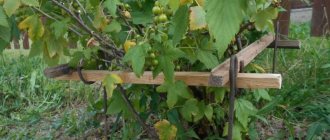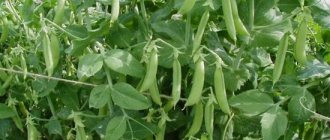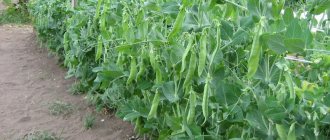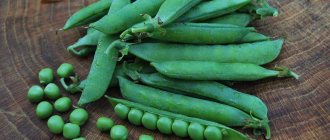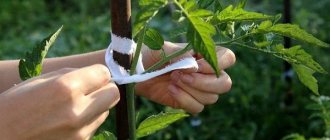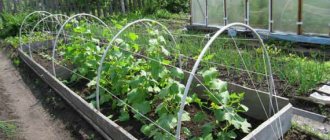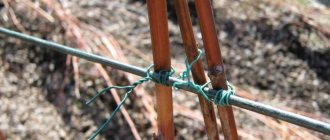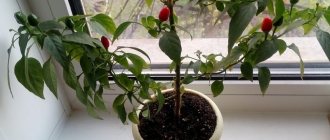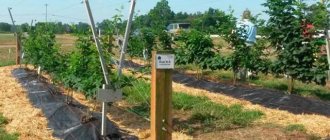Peas enjoy well-deserved respect among gardeners. It is tasty and healthy, unpretentious and easy to grow, frost-resistant and suitable for many Russian regions. To significantly increase the yield of peas, you should know how to properly tie up peas. This is what this article will discuss.
Why do you need a pea support?
Pea gartering in open ground is not always done, but in general it is necessary. Here are the main reasons to follow this rule of agricultural technology:
- the correct garter activates the circulation of air masses between the branches, allowing heat and light to freely reach the lower parts of the crop (as a result, the stems fully develop, and the peas ripen and fill);
- reliable support minimizes the risks of rotting and the development of fungal and bacterial infections in rainy weather;
- with vertical planting, space in the garden is significantly saved;
- a beautiful, well-kept fence transforms a vegetable garden;
- therapeutic and preventive measures are simplified many times;
- It will be much easier to harvest - the pods are clearly visible, overripe fruits can be removed in a timely manner.
Peas without a garter become a target for Burkhus attacks. The pest beetle is considered one of the most dangerous for legumes, capable of destroying the entire crop.
Important! Overripe fruits cannot be kept on the bushes; they can cause them to dry out. Only healthy peas can be eaten; after an attack by beetles, the fruits become poisonous
The garter helps the plant to develop properly. Pea bushes have lodging-type stems of impressive length. Without rising up to the sun, the crop simply will not grow normally.
We carry out the correct landing
If you want to get a large harvest of tasty peas, carefully prepare for the planting season. To begin with, it is worth mentioning that there are four main varieties:
- vegetable;
- sugar;
- stern;
- grain.
Each of them can be grown in the garden plot. But remember that the last two types are used as organic fertilizer for the garden. Vegetable peas are suitable for use in soup, and sugar peas can be eaten fresh straight from the garden. To learn how to tie up peas, first sow them. This is done in several stages:
- Soil preparation. The vegetable loves a lot of light and warmth, so choose a suitable place for it. Urea or superphosphate can be used as soil fertilizer. Throughout the entire period of growing peas, the soil should remain moist. Land in the form of light loam or sandy loam is ideal. Peas get along well in the place where pumpkin or nightshade crops grew.
- Sowing. First, you should inspect the seeds. Separate rotten and broken peas. To improve seedlings, before planting, soak the seeds in boric acid at the rate of 5 liters of water per 1 gram of substance. You should not hold them for more than 5 minutes. Mid-May is considered a favorable time for sowing. This month the soil warms up well and the number of frosts decreases. Special grooves are made in the garden bed. For every meter of it, 15-20 peas are planted. The first shoots can be seen after three to four weeks.
- Care. This is an important step when growing peas. We will devote a separate topic to him and will analyze the main point of how to tie up peas.
Types of supports for peas
There are many interesting solutions for pea supports. When choosing, you need to take into account the characteristics of the site, the intended location of the beds, and the desired decorative properties.
Stakes
The simplest DIY pea supports look quite nice in the photo. Pegs support the bushes; they are a simple, affordable material. They can be installed at any time of the year. Suitable:
- wooden sticks;
- reinforcement rods;
- bamboo branches;
- other branches up to 2 m in length.
Wood is ideal, but others will also work. You need to be careful with metal, it gets hot in the heat and can burn the green parts of plants.
The stakes are driven into the soil with an inclination towards the center, and not vertically, so it will be possible to build a natural hut
Important! Willow branches cannot be used to construct supports, as they immediately take root and grow.
Net
You can properly tie peas in a garden bed in open ground using a net. A metal or plastic base is suitable, sometimes the mesh is made independently. Attach the mesh to stakes, which are evenly distributed around the perimeter. For fixation, use clamps or binding wire. The optimal width of the canvas is about 2 meters.
The mesh can be fixed straight or at an angle of 60°, much will depend on the lighting conditions. The galvanized base is durable and will last for more than one season, the polymer base is also quite strong and reliable.
Important! During the off-season, it is advisable to remove the mesh support fabric indoors.
You need to be careful with metal meshes, iron gets hot in the heat and burns plants (with plastic there will be no such problems)
Trellis
A do-it-yourself pea trellis is a simple and, no less important, mobile option. It is not recommended to grow the crop in one place for two seasons in a row; the trellis can be moved to a new area. To build a trellis, you usually take 8 horizontal slats, 4 bars, twine and screws. Sometimes they make unusual shapes that become a harmonious addition to the landscape of the site.
The trellis should be made immediately during sowing of the crop.
Hut
A hut with green weaving looks very impressive and can become the main accent on the site. To build a living green house, you need to drive stakes about 2 m high on both outer sides and place them at an angle to each other. The letter “L” or a similar structure with a minimum internal space of 100 cm should appear. The sticks at the intersection are secured with rope or twine.
A hut for gartering peas not only increases yield, but also looks beautiful
Wigwam
The pea “teremok” is organized around a pole installed in the center, approximately 2 meters in height. At a distance from the pole, stakes are driven in; you need to make a fence in a circle. Then the stakes are tilted towards the center, connected at the top, and tied. All that remains is to plant the seeds on both sides of the stakes and wait until everything grows.
The pea wigwam is overgrown gradually, which gives the “mansion” a special charm
Bicycle rim
You can also use improvised means for gartering. For example, a rim from an old bicycle can support about 25-30 pea bushes. The knitting needles will need to be removed under the trellis. Instead, wooden crosses are nailed, and threads are pulled between the wheels. The support on the bed is mounted vertically. Seeds are sown from inside or outside the circle. To make the structure stable, tent stakes and construction staples are used for fixation.
No need to throw away your old bicycle rim, it can become a practical garter for pea bushes
Fence
An option for the lazy, but it also has the right to life. You can plant peas along a mesh fence and tie them directly to it. Wooden fences are also suitable; they do not heat up under the scorching rays of the sun.
You can make a garter on a chain-link mesh, but it is advisable that it be coated (so the metal will bask less in the sun)
Standing at attention
I liked this idea: two cords are pulled between two posts at the same level, and a tomato (pepper, eggplant) stem is placed between them. The bush grew bigger - they pulled a couple more ropes, higher, and so on. In theory, even a bush weighed down with fruits should not fall over - it doesn’t weigh a ton. But in practice? If anyone has tried tying up tomatoes or eggplants this way, please share your impressions.
This method is good for individual plantings, and sowings of the same peas can simply be limited to several rows of twine so that they do not lie on the ground.
Variations of rope supports
If you don’t want to “strangle” plantings in a rope hug, pay attention to these methods. The coarse mesh will both support and preserve some freedom for the plant - excellent support. But the practicality of ropes with spacers raises some doubts: it is clear that the bushes will not fall sideways, but what will prevent them from settling between the cords?
I like the grid idea better
Slightly reinforced options for double-sided fencing. To be honest, the reliability of the support in the photo on the left raises doubts. The soil in the garden bed must be loose, then how deep should the slats be so that they can support the weight of the bush with fruits?
The design on the right is only good for low-growing tomatoes, since its height is initially limited. It’s hard to tell from the photo, but it seems to me that it stands freely, not secured with pegs or pins. Such an unstable structure is definitely not for me: there is a high probability of accidentally knocking over the support and breaking the bush while watering or weeding.
READ MORE: Wood-burning stoves for baths: types and features
Strengthened version
How to make a pea support with your own hands
There are a lot of working schemes for constructing a garter. Many of them are extremely simple to set up.
Support for peas made of polypropylene pipes
Economical and original option. Need to:
- Prepare pipes with a sufficient number of connections. Pipe blanks are used with careful trimming
- Make a selection diagram - it can be a simple structure, a hut or an entire greenhouse. An assembly is made from polypropylene pipes like a construction set
- Fasten the fragments according to the diagram. The finished connections come out neat and tight
- Secure the base into the ground.
All that remains is to plant the peas and then tie up the plants.
Important! The crop is planted along the bottom of the supporting structure.
Support stakes
Stakes are the most popular support option, largely due to their availability. As a standard, they are taken based on the support of the plant, but any other options are possible. For the garter, soft fabric is used, it is cut into wide strips. Procedure:
- Prepare supports and garters. The pegs need to be deep enough into the ground so that they remain stable.
- Install the stakes at a distance of 20 cm from each other, creating the necessary architectural shape. Around the stakes you can play around with different shapes for gartering plants
- Plant peas. You can tie up the green parts at your discretion, the main thing is to use soft pieces of fabric
When the crop begins to grow, tie the branches upward.
Wigwam
A green hut-type support looks very beautiful and will become a bright decoration of the site. To do it:
- A pole about 2 m high is driven in the center. Wooden watering cans are the optimal basis for constructing a wigwam garter
- At a distance of 70 cm, stakes are installed, then they are pulled together at the top and fixed. The tilt angle should be around 60°. It is necessary to maintain distances between the base stakes
- Plants are planted on both sides of the structure.
Wooden slats are most often used to form trellises, but other options are also suitable. This could be wire, fittings, etc.
Portable trellis
It is more difficult to make a portable trellis than a base made of stakes, but you can use it for more than one year. Procedure:
- Prepare materials, tools for work - twine, screws, timber, screwdriver. The gardener chooses the base materials according to his taste - these can be wooden beams, metal rods
- Make the base of the structure by fastening the beams transversely using screws. The base must be stable
- Fix 4 vertical supports from the outside at an angle, tie them at the top.
- Pull the ropes. You can give the trellis an unusual shape
Trellis can be moved from place to place and stored in storage rooms.
When do they start tying peas?
You need to start gartering peas when the sprouts reach 20 cm in height and the first tendrils appear. Plants need to be fixed to supports very carefully. The branches themselves will creep up and begin to curl along the base, that is, extra garters are not needed.
Important! After the active growth of peas along the support after tying up, you need to make sure that the branches do not intertwine.
Wire and twine cannot be used for tying peas, since rough materials injure the green parts of the plants. If the plans include the construction of complex decorative structures, supports are made before planting. Low-growing pea varieties are usually planted in holes in pairs. Growing up, they will hold on to each other, this is a conditional garter.
Thin branches are sometimes left just like that, heavy ones must be tied up
Timing of the garter
The need for gartering should be focused not on specific dates, but on the height of the plants and the characteristics of their development. Lodging begins when the plantings grow to 30-40 cm. The garter must be done earlier - when the height of the sprouts is 15-20 cm. A prerequisite is the presence of tendrils with which the crop will cling to the support.
You should think in advance about exactly how the peas will be tied up. If you use a complex structure, then you need to organize it before sowing.
How to tie peas in the garden
Fragile pea stems are usually not tied to supports with ropes. The antennae grow in such a way that, feeling support nearby, they become attached themselves. It would not be superfluous to clean the base from the bark and treat it with an antiseptic.
Important! The health of the crop in the future depends on the correct preparation of the base for garter.
Low-growing varieties do not need to be tied up; tall varieties must be fixed. Garters should not be too frequent - the minimum interval is 20-30 cm.
Recommendations and common mistakes
One of the most common mistakes a novice gardener makes is gartering an overgrown crop. This option can be used, but only for stakes. In other cases, you need to work with young plants or even sow seed material, waiting until it stretches upward along the support, and then make a garter.
Do not use wire to secure garters. Hard materials injure the green parts of plants and can destroy plantings under strong wind loads. At the same time, it is generally not recommended not to tie up peas. Yes, you can do without supports, but the harvest will be much smaller than you would like, the quality of the fruit often decreases, and timely collection of ripe pods becomes difficult.
The method of planting peas near other tall plants so that they act as a support is poor. It is used to save materials, time and effort. But you need to understand that such a close proximity (and if the stems are intertwined, it will be too close) harms all plants. Crops will share nutrients and lack light, which will negatively affect their yield.
The main point of tying peas is to obtain maximum yields
Any type of tree except willow can be used as garter stakes. With almost 100% probability, a young tree will appear in place of yesterday’s peg of this species after gartering. Do not use wooden garter material that shows signs of disease or is infested with pests. In this case, there is a risk of infecting all plantings. Garters should not be very stiff, so wide pieces of fabric are often used. Plastic garters and clips are also a good option. If it is not possible to buy special fasteners, they are replaced with polyethylene, soft thread cords.
The statement about the existence of pea varieties that do not need garter by definition is erroneous. But modern breeding is actively developing, and there are varieties of crops that can more easily endure the hardships of free growth than others and actually do not lose in yield. It is difficult to find them on the open market.
Garter material
When choosing a material for gartering peas, it is important to consider its rigidity. Steel wire and twine are not suitable for such purposes. If the material is too hard, the tied sections may break during wind or rain.
You can choose one of the following options:
- soft fabric - it needs to be cut into narrow strips, the material must be strong enough to withstand the season;
- thick threads;
- cord made of plastic or polyethylene;
- hemp;
- plastic garters with snap;
- special clips - such devices resemble clothespins; you can buy them in the store.
